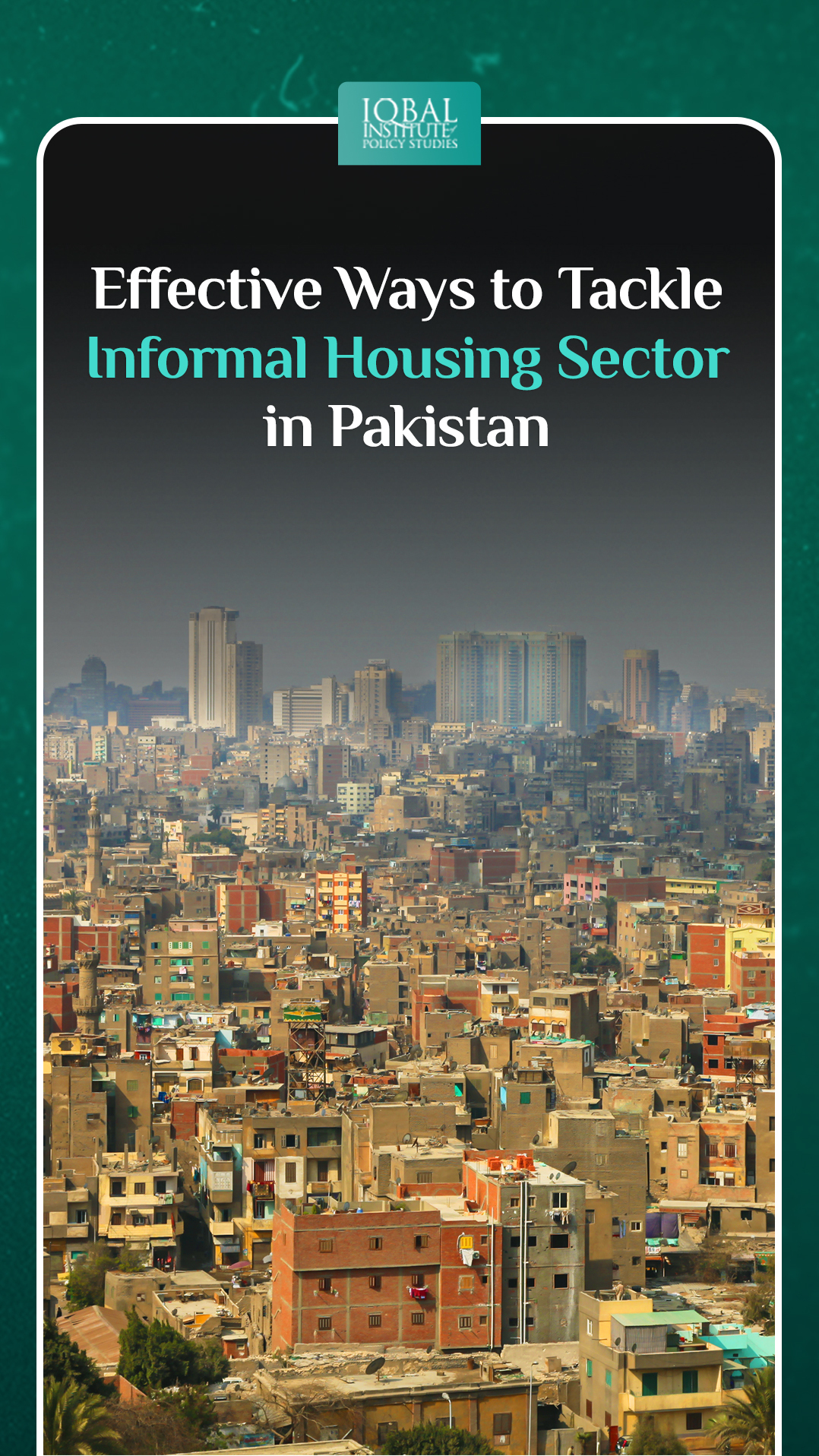The informal housing sector is huge and diverse. At present, multiple cities are flooded by low-income individuals in the form of informal settlements, often in public and marginal areas. These individuals have to live in sub-standard and unaffordable housing, which contributes towards repressed economic growth and social productivity. Where informal settlements have already been established, policy options become more challenging. In the past, policymakers and stakeholders have worked to tackle the global issue of informal settlements. However, they have failed to provide adequate, affordable housing to accommodate and service urban citizens. Strengthening the private sector to combat the looming housing shortage mostly resulted in unplanned neighbourhoods and low-density areas deprived of necessities. Therefore, upgrading these settlements is insufficient to keep up with the current and future housing demand. Effective policies and strategies are essential to achieve long-term goals and objectives. Forging and developing policy frameworks can lead to socio-economic development. Moreover, they can act as a blueprint for achieving efficiency, guidance, consistency, and clarity on innovative land management tools and help unlock the potential of idle resources.
How is Pakistan Addressing its Informal Housing Sector?
Unplanned urbanisation in Pakistan has resulted in the widespread existence of poverty and slums. Most of the inhabitants of informal settlements lack adequate income, job security, and access to services and infrastructure. Pakistan’s urban population in 2018 was 40% (The World Bank, 2018). With the increase in population, the demand for housing also increases. There is a backlog of 8.5 million housing units in Pakistan, accelerating to 0.2 million units per year (Hasan & Arif, 2018). Every government has ensured adequate housing and new strategies to minimise the growth of slums but has failed to understand the housing crisis and its dynamics. For example, in 2015, CDA forced slum eviction in certain areas of Islamabad without relocation, resettlement plan, or negotiation offer to consult with the slum dwellers (DAWN, 2015). Recently, Sindh provincial cabinet decided to regularise Katchi Abadis in the province formed from 1997 to 2011. This act is largely controversial and has been revisited multiple times (Siddiqui, 2022).
Furthermore, informal settlements in the urban centre are slowly becoming high-rise leading to problems of urban densification. In 2020, approximately 11.9 million people reside in slums or underserved areas, out of which 86% of inhabitants are permanent settlers, 13% are temporarily displaced, and 1% belong to other nationalities (UNICEF, 2020). The politician-developer nexus developed luxury gated communities for the upper and middle class, segregating the cities into poor and rich areas. This is supported by huge funds from international organisations leading to massive speculation that needs to be curtailed. This speculation has put housing beyond the reach of low-income individuals. Also, inefficient urban planning in the country has ignored urban economic development for decades which should be at the forefront of economic policymaking. Therefore, addressing urban poverty and sprawl in Pakistan has become crucial. The governing bodies must consider actions at both institutional and policy levels to ensure the provision of secure, affordable and sufficient housing for all.
Ways to Reduce Informal Settlements
Utilise Vacant Property
Vacant properties, buildings, and cargo containers which do not generate income or contribute towards social or economic productivity should be converted into permanent supportive housing for low-income individuals. This method is efficient and inexpensive compared to new construction, as it only requires installing small kitchens and other basic amenities. For example, Los Angeles passed two laws to convert vacant motels into homeless housing (Reyes & Smith, 2018).

Effective land use
The government must collaborate with the private sector, non-governmental organisations, and community housing groups to build, develop or renew social housing units and make them affordable for low-income groups. Profits should be re-invested in social housing, community facilities, and public space.
Land Acquisition
In China, local governments have limited power to take over rural land for new housing. They are accessing various tradable land quotas through which developers are permitted to construct new housing in the boundary of a city in return for opening up additional land for cultivation beyond city boundaries (World Economic Forum, 2019). Also, traditional land planning and zoning are mostly ineffective and expensive. Therefore, Pakistan must experiment with similar policies that can generate high compensation for land owners to transfer developing rights. This can address the acute affordable housing shortage and lessen the development pace of informal settlements.
Finance
Adequate and affordable housing supply can be provided by combining or sharing publicly owned assets into an urban wealth fund that collaborates with private corporations to deliver the projects. Sharing prospects and challenges orients stakeholders’ interests and can align infrastructure development, planning, and land regulations.
Improving Construction Productivity
A lack of construction skills can elevate the skilled workforce’s cost and, in turn, housing construction costs. Therefore, the government must invest in training and skill development programs which can be useful for the construction industry. This will reduce the rents and housing prices, minimising the formation of urban slums.
Green Designs
Green designs, such as affordable vertical developments with green rooftops and solar panels, should be encouraged in all socio-economic sectors. In the long run, this will add to the benefit of lower-income groups in the form of improved air and water quality and cheaper energy bills. For example, the Indian Institute of Technology in Madras has developed a system that uses gypsum waste from fertiliser plants in its construction. It is a low-cost, energy-efficient design that provides affordable and sustainable housing to the rapidly growing population (Cherian, Menon, & Prasad, 2016).

Criteria for Affordable Housing
Government must construct affordable housing with strict eligibility limited to those who do not own any property and earn an income under a specified limit. The ranking should be based on employment status, income, literacy level, age, and the number of children. To ensure transparency, regulatory authorities must digitise data through proper verification and inspection.
Tenure System for Housing
Housing schemes and projects must be developed based on multiple tenure systems. Some houses should be sold at market price, while others should be made available through tenures, including co-ownership and rent-to-buy. This scheme will benefit the individuals who cannot afford housing in urban cities and are forced to accommodate informal settlements. For example, “Options for Homes”, a project in Toronto, has successfully delivered 6000 affordable homes in 20 years through easy tenure systems, making homeownership affordable (Options for Homes, 2022).
Housing Ownership
Thailand’s Baan Mankong Program is a community-driven project which aims to upgrade slums by involving government, NGOs, experts, and residents of informal settlements. This empowers the government to determine where and how they want to improve their community and allows low-income households to take ownership of their housing development (Norford & Virsilas, 2016). Pakistan can adopt a similar program in its policies to develop slums.

Conclusion
Addressing Informal settlements is crucial as it strains a country’s service delivery and economic productivity. This would require effective systematic changes in the policy and institutional frameworks to ensure the provision of affordable housing for all to minimise the development of informal settlements in the first place. Pakistan must adopt various successful programs and laws developed countries implement to tackle its housing crisis.



Leave a Reply